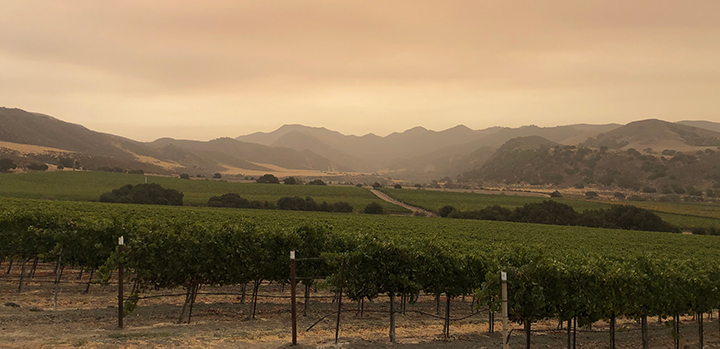Smoke Taint

A chemical and technical perspective
By Associate Professor Federico Casassa
As wildfires continue to ravage the North Coast of California, bringing even more chaos to the wonderful and terrible year of 2020, concern about the risk of smoke taint has grown among growers and winemakers alike.
Smoke taint, as its name suggests, is a taint. A taint is a volatile compound that either brings an unpleasant aroma or taste to a wine or masks the positive fruity aromas of an otherwise sound wine. A taint comes from an external source to the grape or wine environment.
This aptly applies to smoke taint, which is the result of a series of volatile molecules known as volatile phenols that are released when lignin, a major structural component of wood, burns. As wood burns, these volatile phenols travel with the smoke and land on the grapes and leaves.
Volatile phenols are tricky. As soon as they land on the berries, they quickly sneak inside, where they partner with the most abundant solute of grapes — sugars. In doing so, these volatile and smelly phenols turn into glycosylated phenols — or phenols that are bound to a sugar molecule — which makes them nonvolatile.
And if you are chemist reading this, you might cheerfully proclaim: “problem solved” since nonvolatile compounds are, well, nonvolatile — which means they can’t be smelled. But these compounds are tricky.
Once grapes are crushed and alcoholic fermentation sets in, the enzymes of the yeast cleave this bond between the phenols and the sugars, freeing the free phenols again into the atmosphere, effectively turning them volatile again.
So as alcoholic fermentation progresses and the sugary must is converted into wine, these volatile phenols continue their annoying release into the volatile composition of the wine.
The end result?
The wine quickly develops aromas similar to campfire, liquid smoke, stable with burnt and medicinal notes. Interestingly and anecdotally, some individuals — me included — have reported that upon drinking and swallowing some of these heavily tainted wines (the 2017 harvest in Napa and Sonoma was particularly hit hard by this and so was the 2008 vintage in Mendocino County), they have an intense ashtray taste to them.
Very recent research has shown that human beings have certain enzymes in their saliva that can also cleave some of these bound phenols that escaped fermentation, further releasing the free and stinky phenols into the mouth, resulting in an enhanced perception of the smoke taint as the wine is swallowed.
What can we winemakers do about it?
Very little, sadly.
Washing grapes won’t do, but we know that grapes with ash on them should probably be washed prior to crushing. Fining agents — additives added to wine to tweak it’s chemistry — have very little effect. But when they do, they strip the volatile phenols as well as everything else that is volatile, which is not good for anyone wanting to smell the wine.
Certain filtration techniques, such as reverse osmosis, do work but again, other wine components are stripped along the way. The best a winemaker can hope for is to not have to deal with smoke taint. As a side note, if the crop is insured, a claim can be filed, but the insurance company will request an analysis confirming the presence of these volatile phenols in the grapes prior to processing them into wine.
Central Coast residents were exposed to heavy smoke and poor air quality between Aug. 16-20, 2020 — the result of a fire complex in Monterey county.
What does this mean for the county’s grapes?
It’s hard to tell until the grapes are fully transformed into wine because, as it was explained before, it is the it is the process of fermentation that reveals these smoky aromas. We know, however, that in order for smoke taint to cause a real problem, the smoke needs to be at least 24 hours fresh. As smoke travels, its taint capacity diminishes. The fact that the wind patterns did change and the skies of San Luis Obispo County did clear, combined with the fact that the smoke we got was probably more than 24 hours old, we remain hopeful that little or no effect will be seen on grapes and the resulting wines.
While smoke taint is now poised to be a perennial issue in California, any environmental odor that remains in the atmosphere surrounding a vineyard for a relatively prolonged period of time can land on the grapes, make it into the wine, and eventually show up uninvited into consumers’ favorite glass of wine.
Yet another excellent reason to keep the environment clean and nice-smelling.
Visit Vines to Wines Fall 2020 to read more stories.